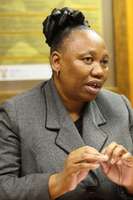
The Minister of Basic Education, Mrs. Angie Motshekga, has said that both short-term and long term policy changes to teaching and learning will be implemented. These include:
The Outcomes Based Education model that was adopted by the new Government in the late 1990s received much criticism and was often cited as the explanation for poor schooling in South Africa. Now that changes have been brought to the curriculum, there is an expectation that these alone may improve the quality of education in our schools. Data published by the Institute in a Fast Facts report this month suggests that this may not, however, be the case.
The data we published is a review of how well school pupils performed in South Africa based on their race and then the type of school they attend. By type of school, the review looked at former ‘Model C’ schools, former House of Representatives Schools, former House of Delegates schools, and what we have termed ‘other schools’ that did not fall into any of these three categories. House of Representatives (HoR) schools were reserved for coloured pupils and House of Delegates (HoD) schools for Indian pupils. ‘Other schools’ were run by the former homeland governments and the former Department of Education and Training for black pupils.
The former ‘Model C’ school originated in the early 1990s. Mr. Piet Clasé, minister of education at the time, gave white, or House of Assembly schools, a choice of three models of schooling that would shape their characteristics and nature for the future. ‘Model A’ would make the schools fully private. ‘Model B’ would see them remain state schools, and ‘Model C’ would make schools semi-private. ‘Model C’ schools would receive state subsidies of about 50%, although the balance would have to be raised through fees and donations. Black pupils were permitted to comprise 50% of the student body.
By April 1992 approximately 1 900 former white schools had become ‘Model C’ schools. This equated to 95% of all schools under the control of the House of Assembly.
In 2009, these four types of schools produced a total of 339 144 pupils who passed matric. Of these, 254 287 were African, 29 340 were coloured, 13 630 were Indian, and 41 837 were white. Former ‘Model C’ schools produced 70 006 of the passes, former HOR schools produced 20 850, former HOD schools produced 16 887, and the ‘other schools’ produced 231 382 passes.
The really important information was the pass rates. In former ‘Model C’ schools, 93.7% of pupils who wrote matric passed. In former HOR schools the pass rate was significantly lower at 68.4%. Former HOD schools produced a pass rate of 84%. In the ‘other schools’ the pass rate was a disappointing 52.9% - well under the national average of just over 60%.
In no type of school did white pupils achieve a pass rate of under 96%. The pass rates for the other three race groups varied significantly depending on the type of school they were in. African pupils for example achieved a pass rate of 88.4% in former ‘Model C’ schools but this rate fell to 52% for African pupils in ‘other schools’. Coloured and Indian pupils showed similar but less dramatic fluctuations. If a coloured pupil attended a former ‘Model C’ school, they had an 87.7% chance of passing matric. In a former HOR school that percentage fell to 69.9%. While 97.9% of Indian pupils in former ‘Model C’ schools passed matric, their pass rate fell to 82.6% if they attended former HOR schools.
The point is a fairly obvious one, but it bears making in South Africa’s often confusing education policy environment: that the environment wherein pupils are taught is more important than how or even what they are taught. The environment is a product of how the resources made available to any one school are managed. Doubtless former ‘Model C’ schools have resources well in excess to those of the ‘other schools’ for example, but those resources create an enabling learning environment only if they are properly managed.
This brings the argument back to the praise that has rained down on the Department of Basic Education following their announcement of proposed reforms to the OBE curriculum. These are, without exception, good and welcome reforms and the department has obviously been very well advised on some of what is wrong in the education system. But the examples we have cited above establish without any doubt that in the absence of effective management of schools and allocation of resources, the reforms will fail to make the impact that they potentially could.
- Frans Cronje
